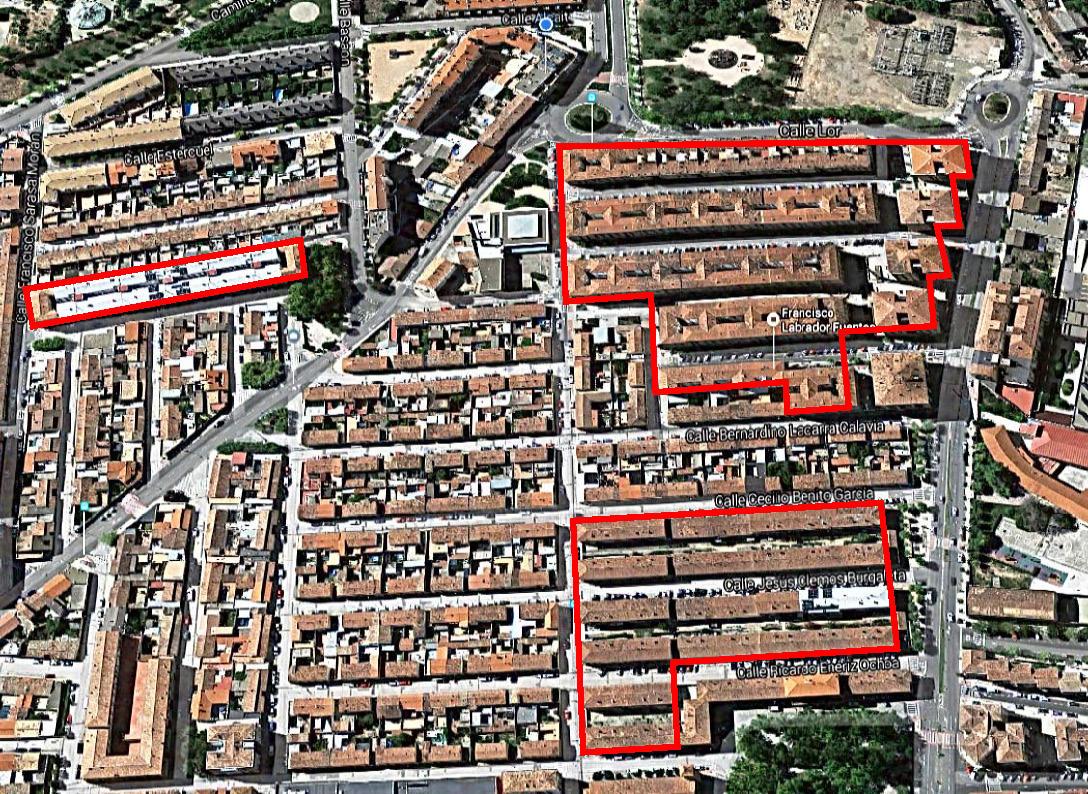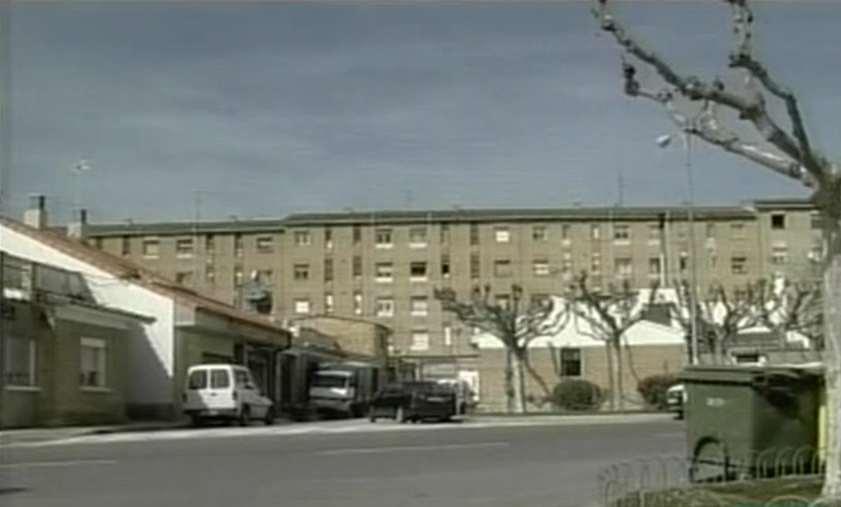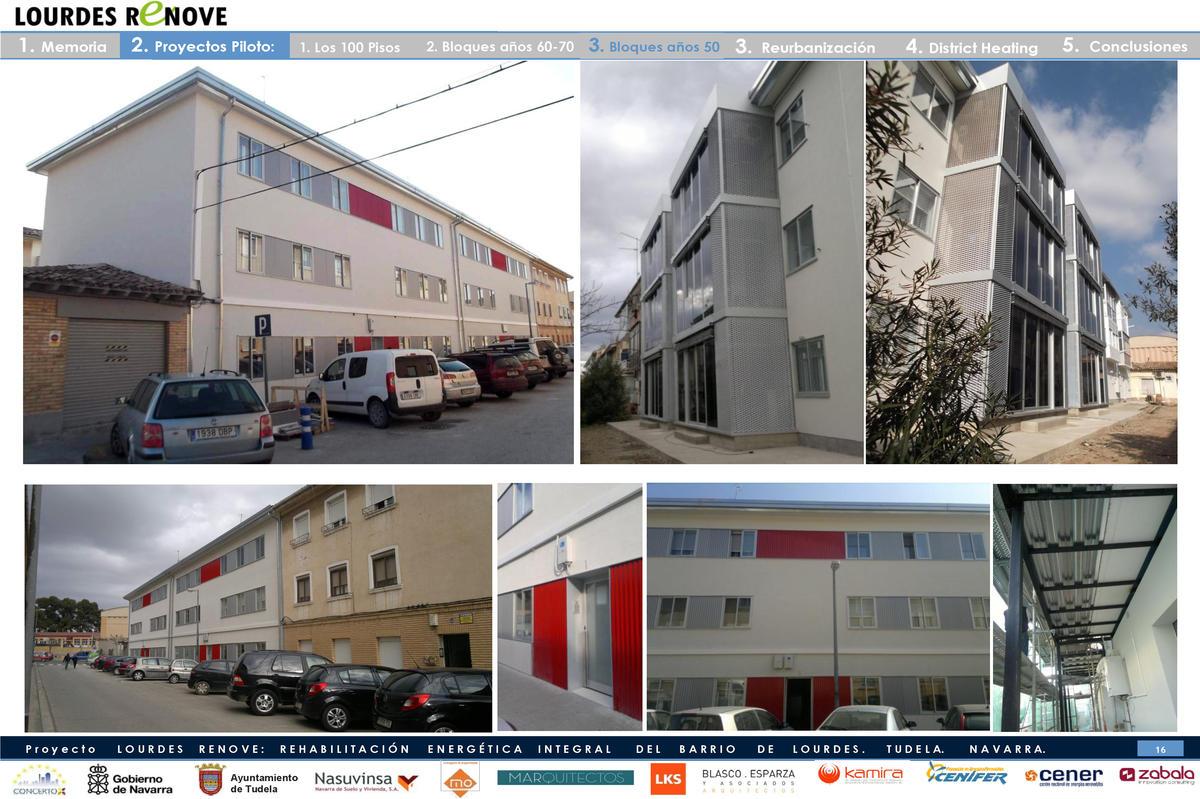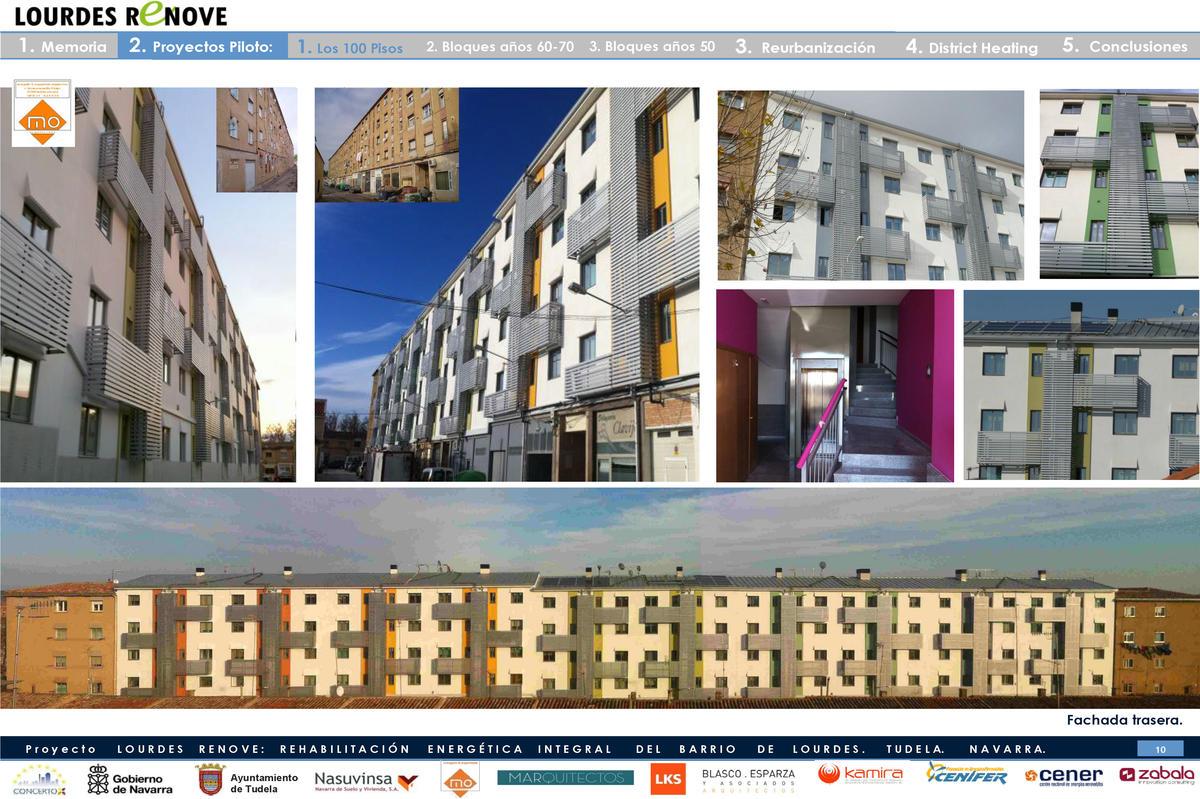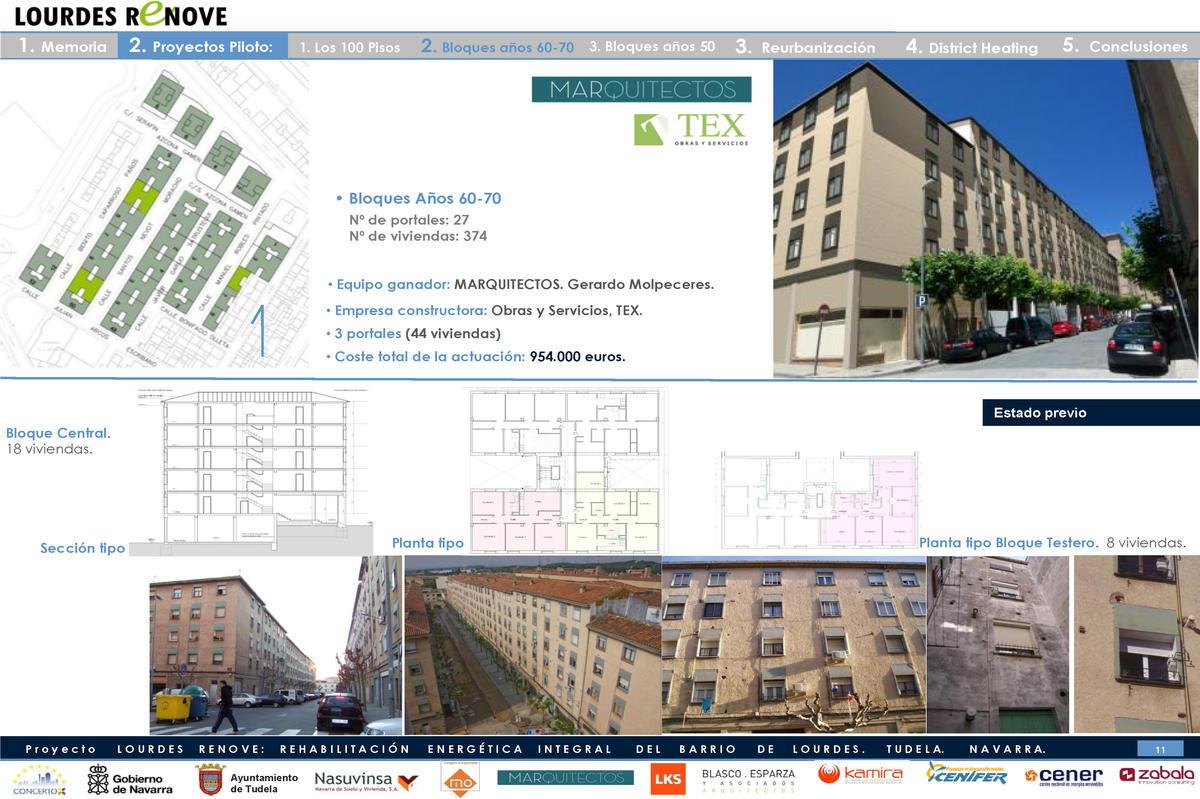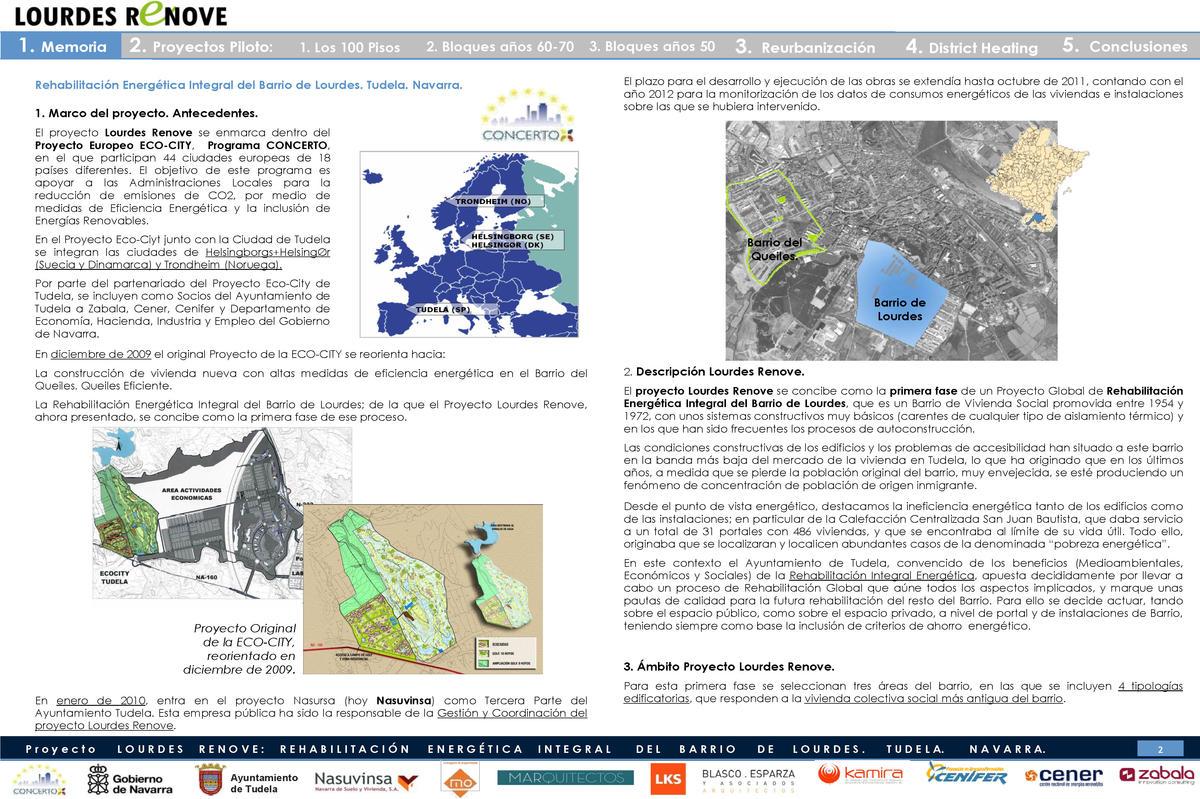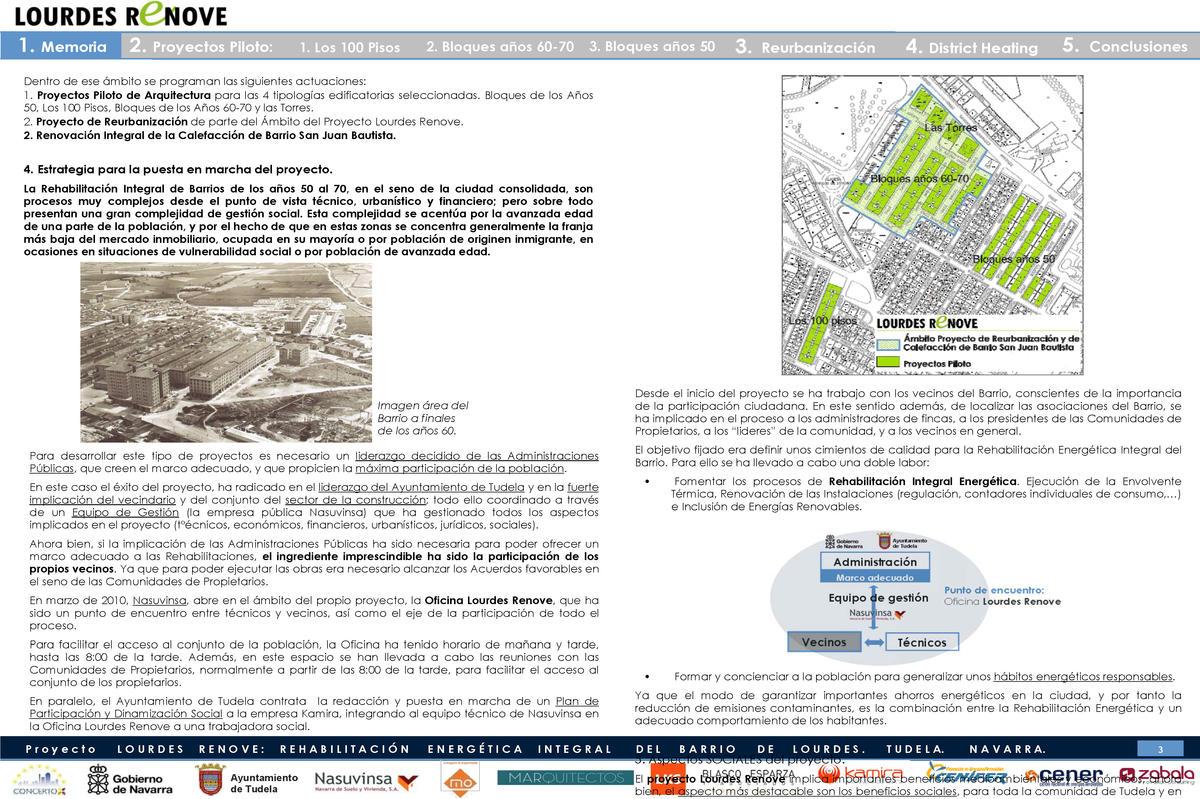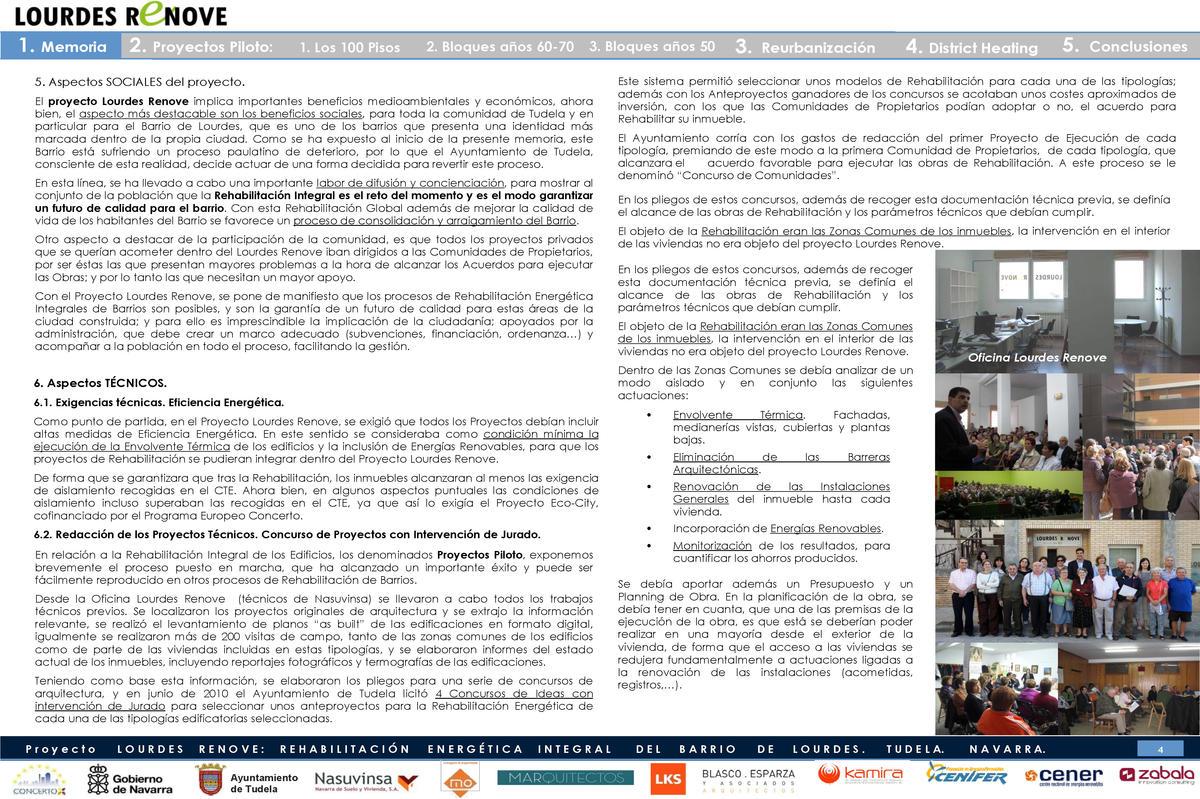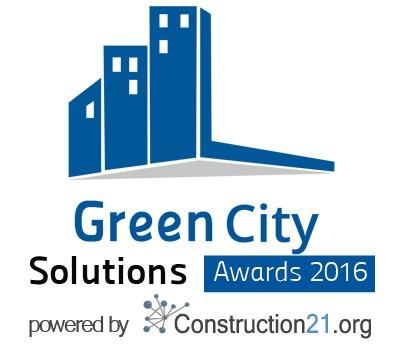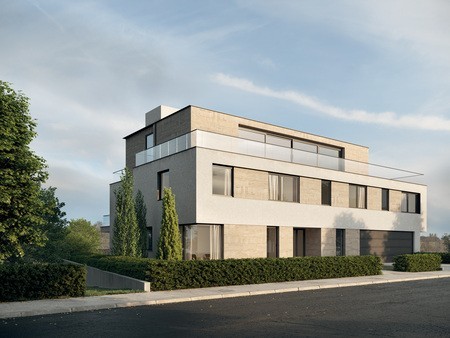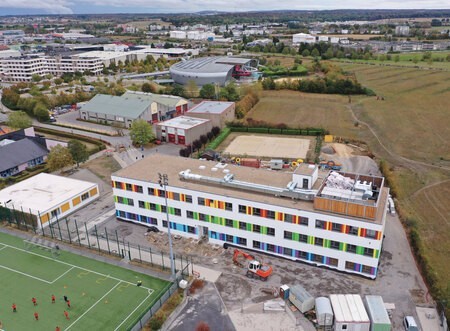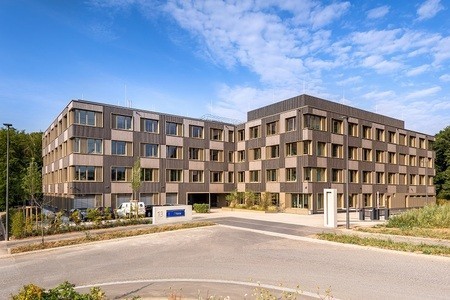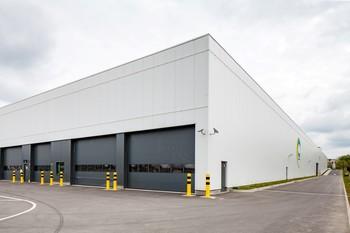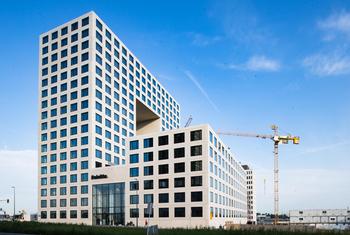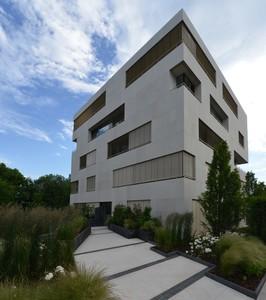Energy rehabilitation of the Lourdes district in Tudela
Last modified by the author on 29/06/2016 - 14:15
- Address 1 - street : delgado g TUDELA, España
- Population : 8 000 hab
- Number of jobs : 28 empleos
- Starting year of the project : 2010
- Delivery year of the project : 2011
- Key words : INTEGRAL ENERGY REHABILITATION OF DISTRICT, complex, pedestrianization, COLLECTIVE BUILDINGS, CHANGE OF SYSTEM BOILER
-
16 ha -
6 926 980 €
Energy rehabilitation of residential building in the Lourdes neighborhood in Tudela
ECO-CITY of Tudela (2006-2011). Project within the framework of the Concerto Program, an initiative of the European Union that supports local communities in the reduction of CO2 emissions. Through improving Energy Efficiency and Renewable Energy inclusion.
It involves 44 European cities in 18 different countries.
In this action the European partners of the City of Tudela are the cities Helsingor (Denmark), Helsingborg (Sweden) and Trondheim (Norway).
The Lourdes Renove project is conceived as the first fase of a global project of Integral Energy Rehabilitation of Lourdes Neighborhood, a social housing neighborhood, promoted between 1954 and 1972, with very basic building systems (lacking thermal insulation of any kind) and where autoconstrucción processes have taken place.
Construction conditions of buildings and accessibility problems have placed this district on the lower side of the housing market of Tudela, which has originated that in recent years, as the original, very old, population of the neighborhood is lost, a phenomenon of depopulation and concentration of immigrant origin is happening.
From the energy point of view, we highlight the energy ineficiency, both for buildings and facilities; in particular the central heating of Juan Bautista, which served 31 full service portals.
Programme
- Housing
- Public facilities and infrastructure
- Public spaces
- Green spaces
CO2 Impact
613 tCO2
Method used to calculate CO2 impact
Datos reales sobre mediciones monitorizadas durante una campaña completa 2011-2012
Campaña 2010-2011 347.043,00 m3 consumidos
Campaña 2011-2012 61.878,45 m3 consumidos
total reducción del gasto % 82,17 %
Project progress
- Management phase
- Delivery phase
- Operational phase
Prescriptions and zoning
- Particular conventions
Key points
- Governance
- Quality of life
- Economic development
- Mobility
- Energy /Climate
Approaches used
- Agenda 21
- Others
Certifications
- Autre
More info
http://www.tudela.es/docs/industria/lourdes-renove-presentacion.pdfData reliability
Assessor
Type of territory
Working class neighborhood created by the Jesuits in the 50-60 as a solution to housing problems for people coming from the countryside to the city. The building systems are very basic (lacking any kind of thermal insulation) and autoconstrucion has been a frequent process.
Construction conditions and accessibility issues, have placed these buildings on the lower side of the housing market of Tudela, which has meant that in recent years, as the original, elderly, population is lost, a phenomenon of concentration of immigrant population is taking place. They are finding vulnerabilities and even loss of neighborhood identity.
The crisis has hit very strong in this neighborhood that has slowly been losing quality of life in the area and the environment.
The action aims to regenerate the area based on a series of actions at urban level, mixed management: public and private and solution accessibility and energy improvement of housing by performing pilot building projects and change the energy system and improvement of boilers to return to regain a sense of identity.
- Economic and financial situation.
Lourdes district is characterized as a working-class neighborhood and has been severely beaten by the current economic crisis. In this sense it was essential to find a financial model that would allow the project Lourdes Renove. So that in parallel to the process of architectural competitions, and prior to any contact with the Community of Owners, was sought:
- The maximum financial support by the different administrations (Europe, Departments of Government of Navarre and Tudela City Council).
- Financing the whole performance. Offered by the CAN (Caja de Ahorros de Navarra), 100% of the investment, and part of funds from the EIB.
So that the average percentage of aid in the Project Lourdes Renove rises to 59.50% of the investment.
Climate zone
[Cfb] Marine Mild Winter, warm summer, no dry season.
More info
http://www.nasuvinsa.es/es/proyecto-lourdes-renoveNeighbourhood paved surfaces
8 000 m²
Green areas, roofs included
450 m²
Public spaces area
875 m²
Housing floor area
52 740 m²
Refurbished floor area
52 740,00 ha
Number of residential units
586
Number of social housing units
586
Green spaces /inhabitant
Public spaces/inhabitant
Total investment costs (before tax)
6 926 980 € HT
Amount of the investment taken in charge by the local authorities
906 303 € HT
Total of subsidies
1 308 000 € HT
Detail of subsidies
Concerto Program: 870,000 euros
Government of Navarra: 1.400.000 euros
Municipality of Tudela: 305.000 euros
Municipality of Tudela (extraordinary precariousness Aid) = 35,000 euros
Project holder
Project management
- Strategy for the implementation of the project.
- Promote processes Integral Rehabilitation Energy. Thermal Envelope execution, renovation of facilities (regulation, individual consumption meters, ...) and Inclusion Renewable Energy.
- 3. Redevelopment
- 4. District Heating
Project stakeholders
MY CITY OF TUDELA
Other
The Lourdes Renove project is conceived as the first phase of a Global Project Comprehensive Energy Rehabilitation of the District of Lourdes, which is a neighborhood of social housing promoted between 1954 and 1972, with very basic building systems (lacking any kind of thermal insulation ) and in which there have been frequent constructive processes autoconstruction. Conditions of buildings and accessibility issues have placed this neighborhood in the lowest band housing market in Tudela, which has meant that in recent years, as the original population of the district is lost, very old, it is producing a phenomenon of concentration of population of inmigrant origin. From the energy point of view, energy inefficiency highlight both the buildings and facilities; in particular district heating San Juan Bautista, that served a total of 31 portals with 486 homes, and that was at the end of their useful life. All this originated that were located and locate many cases of the so-called "energy poverty"; .In this context the City of Tudela, convinced the (environmental, economic and social) benefits of the Energy Integral Rehabilitation firmly committed to carrying out Global rehabilitation process that combines all aspects involved, and mark quality guidelines for future rehabilitation of the rest of the neighborhood. To do this it chooses to act, both in the public space, and in the private space, at the level of portal and facilities Barrio, always based on criteria including energy savings.
María Rosa Domínguez Berges, mail: [email protected] tfno contacto: 948417116
SOLUTIONS
- Urban project governance
- Citizen participation
611,00 tCO2
Quality of life / density
This project shows that the processes of Integral Rehabilitation Energy Barrios are possible and are the guarantee of a quality future for these areas of the city; and it is essential for them to have a strong involvement of all public administrations and residents themselves. Along with the involvement of technicians and companies in the construction sector. The quality of life for the residents can be improved by improving accessibility and good thermal comfort.
Net density
Social diversity
It is a remarkable fact that the Lourdes neighborhood, despite being one of the neighborhoods that has a more marked identity, is undergoing a gradual process of deterioration, so it was decided to act to reverse this process.
The Integral Rehabilitation of 50s to 70 neighborhoods, within a consolidated city are very complex processes from the technical, urban and financial point of view, but above all a highly complex social management. This complexity is accentuated by the aging of part of the population, and the fact that in these areas there is generally a concentration of the lower strip of the housing market, usually occupied by immigrant population, sometimes in social vulnerability.
To develop this project, a strong leadership of public administration has been applied, the role played by architects, administrators, neighborhood associations, owners and especially THE PARTICIPATION OF THE NEIGHBORS.
There has been an important outreach and awareness effort, to show the whole population that Integral Rehabilitation is the challenge of the moment it is how to ensure a quality future for the neighborhood. In addition a process of consolidation and entrenchment of the neighborhood is favored.
All private projects undertaken within the Lourdes Renove were directed to the Community of Owners, being these the ones with major problems in reaching agreements to implement the rehabilitation works and therefore in need of more support.
Social inclusion and safety
The Lourdes Renove project and Lourdes Renove office and all agents that carry out the project, have made an effort to access the whole Community, to clearly convey the information generated.
To work the issue of social inclusion, Kamira company was been hired to draft a Participation Plan and Social Revitalization. Within this plan there have been developed dynamic activities aimed at the entire district, such as workshops, seminars, a "mosqueo campaign", editing a video ... It also has worked with specific associations such as the Association of Women or the day care center in the neighborhood.
Also aware of the serious economic situation of the neighborhood all economic means available to achieve the maximum level of aid hav been movilized. Funds from Europe (Concerto Program), Aid for Rehabilitation Department of Housing Government of Navarra, IDEA funds managed by the DRIEMA the Government of Navarra and funds from the City Council of Tudela, which was implemented through a coordinated Aid ordinance.
Regarding the Ordinance aid approved by the City of Tudela, in addition to general aid work aimed to all the Communities of Owners, special grants were approved as extraordinary situations Precarious Aids, aimed at sector the population with greater economic problems, which are intended to reduce labor costs owners with fewer resources.
Local development
The performance involved the creation of jobs during the works on the neighbors who were unemployed.
"We have opted to revitalize a sector hit hard by the crisis as the construction sector betting on comprehensive rehabilitation. The rehabilitation of neighborhoods will be the future and the great commitment of many entities for local development".
% of public spaces
SOLUTIONS
- Circular economy
% Paved surfaces
SOLUTIONS
- Citizen-awareness
Climate adaptation, resources conservation, GHG emissions
Integral renovation of the heating San Juan Bautista. Since it was found that the main problem of the facility was placed in distribution networks, the scope of the project was reoriented.
Promote the inclusion of new models and companies (energy supply companies) to minimize investments to be made by the neighbors.
Comprehensive Renovation of a centralized district heating installation.
Acting on the centralized heating (District Heating) San Juan Bautista, he has sought to achieve two objectives:
Allow the survival of this facility, which was at the limit of his life, through a comprehensive renovation and inclusion of renewable energy (biomass).
Show society that Neighborhood heating, in good condition, and applying current media facilities are very efficient, and easily allow the inclusion of renewable energy. With the ultimate goal to promote the extension of this model to new areas of the city, in a country like Spain, where these facilities are relatively rare; and because of the bad press that buildings from the 60-70 years have.
In short, it seeks to boost the performances of renewal on these obsolete facilities to prevent loss, showing the advantages of these systems so that they expand territorially bringing together a large number of buildings in both urban land consolidated and new developments.
Energy sobriety
|
2.3. SUSTAINABILITY |
|
2.3. 1 Tudela City Council has a strong commitment to sustainability. Within this accessions commitment mention the following:
In 2000 the City of Tudela writes a municipal environmental audit, and initiates the Local Agenda 21. On February 28, 2001 in the full City Council approves Environmental Declaration and Action Plan within the Local Agenda 21. The following are some of actions undertaken in the context of the strategic guidelines of the Local Agenda 21:
Regarding awareness and dissemination from the city of Tudela they have organized the following conferences:
|
|
2.3. 2 From the specific point of view Project Lourdes Renove, as one of the two branches of Eco-City Project, to recall that all actions undertaken integrate sustainability criteria, since all the actions should result emisionesde reducing CO2. All actions taken are aimed at:
Since how to ensure significant energy savings in the city, and therefore emissions reduction is the combination of both measures (Energy + Habits responsible Rehabilitation). |
Energy mix
INTEGRAL RENEWAL OF THE HEATING OF SAN JUAN BAUTISTA. It was a district heating system (district heating), that serviced a total of 486 homes and 31 portals, including 2 building types: residential blocks compact between party ("Blocks 60-70 years") and a serial exempt towers ("Las Torres"). With a heated built area of 40.448m² approximate.
This heating was at the end of their useful life, with significant operating problems in production and mainly in the Distribution Network; with significant leakage problems, imbalances installation, ... as well as problems caused by the original design of the facility.
Integrated Facility Renewal contemplated:
- Construction of a new Biomass Boiler Room, in the space occupied by the old oil tanks, which were in disuse. Biomass provides the base heat installation. 2 boilers were installed Viessmann PYROTEC 720 model 720 kW rated power.
- Complete renovation of the Gas Boiler Room. With the installation of 3 condensing boilers HOVAL brand ULTRAGAS 720 model with 665 kW nominal power; these boilers only enter into operation when demand is not covered by biomass boilers.
- Complete renovation of the Distribution Network. General distribution network between buildings in the public space (coordinating it with the Redevelopment Project) and local. Distribution Network for the common areas of the buildings. Distribution Network within the housing 486; inside homes have ringed all radiators, steam traps and placed renewed thermostatic valves. Old installation has only been preserved radiators
- Monitoring systems installation and individual consumption counters.
- Environmental:
- The main power supply of the new facility is biomass, so that the gas used over the previous year has been reduced by 83.8%. Biomass has a great advantage from the environmental point of view, since it is regarded as neutral from the point of view of emissions according to the Kyoto Protocol; so that CO2 emissions are also reduced by 83.8%.
Note: Gas consumption comparison between campaign 2010-2011 and 2011-2012.
|
heating season |
KWh PCI Gas Natural |
Difference |
Saving (%) |
|
2010 -2011 |
4.010.635 |
|
|
|
2011-2012 |
650.697 |
-3.359.938 |
-(83,8%)
|
|
heating season |
KWh PCS Gas Natural |
Biomass tons |
Emissions Ton/CO2 |
Saving (%) |
|
2010 -2011 |
4.456.261 |
0 |
574,86 |
|
|
2011-2012 |
722.996 |
355 |
93,27 |
-(83,8%) |
- Economic:
- The energy consumption of the 2010-2011 campaign amounted to a total of 4,010 MWh PCI in the campaign 2011-2012 (with the new installation) consumption has been reduced to 2,372 MWh PCI; implying a 40.9% energy reduction. Note that this saving is basically to improve the installation, since the total of 31 portals just 3 have executed the thermal envelope; in the case of buildings with termical savings over 60%.
Energy consumption comparison:
|
Heating season |
KWh PCI Gas Natural |
(%) |
KWh PCI Biomass |
(%) |
KWh PCI Total |
Difference Saving |
|
2010 -2011 |
4.010.635 |
(100,0%) |
0 |
(0,00%) |
4.010.635 |
|
|
2011-2012 |
650.697 |
(27,4%) |
1.721.462 |
(72,57%) |
2.372.159 |
-1.638.476 -(40,9%) |
- Energy produced with biomass in addition to being cheaper than that produced with natural gas, shows greater price stability compared to Natural Gas. This aspect has an important implication because the 72,57% of the energy of the 2011-2012 Campaign has produced biomass.
- Biomass generates local employment and reduce dependence on foreign energy by minimizing the consumption of fossil fuels.
SOLUTIONS
- Inclusion of a renewable energy source, biomass.
- Biomass in a cheaper energy.
- Reduction of CO2 emissions into the atmosphere.
- A. New Boiler (gas and biomass)
- New Distribution Networks:
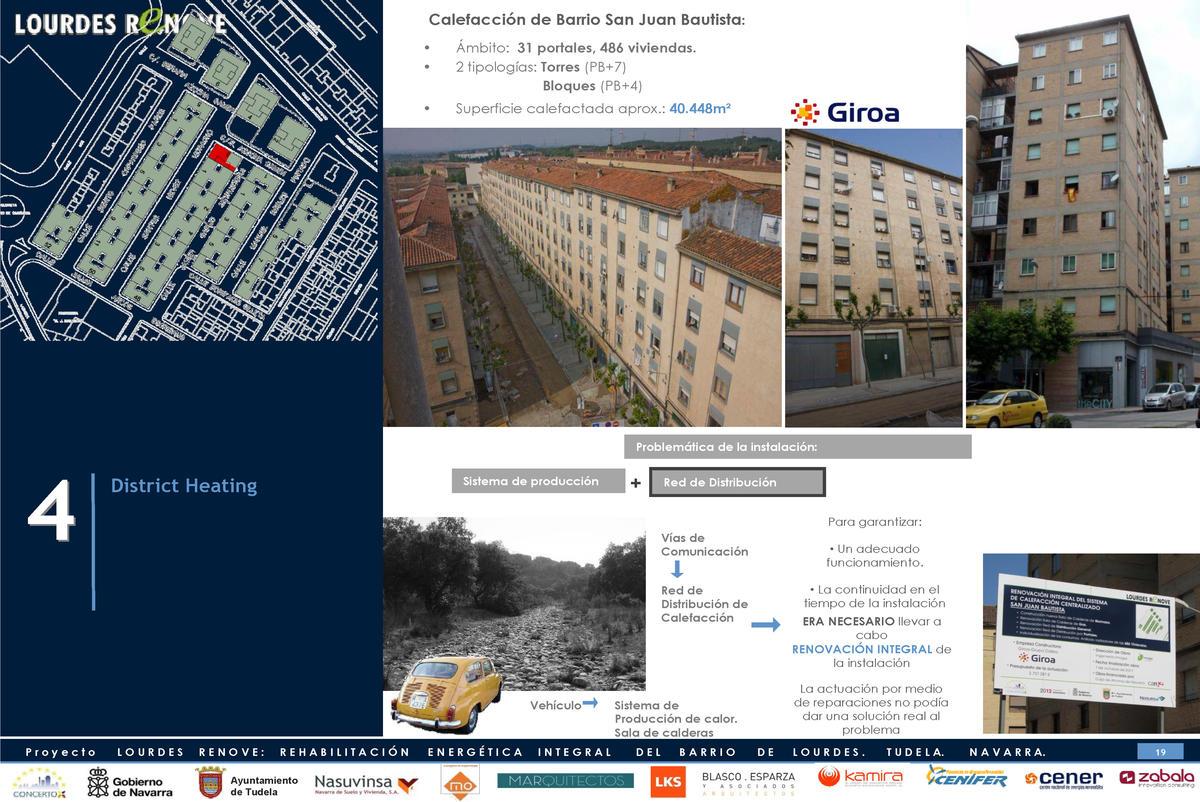
- General (streets and portals).
- Individual (Ringed radiators, meters and thermostats for each of the houses).
- Ensure adequate temperature in all homes. Balancing networks, and possibility of having adequate pressure on networks.
- Reduce energy losses (isolated from all pipes).
- It will regulate the temperature inside the housing (thermostats).
- It will account for individualized consumption.
- Renewable energies
- Urban Lighting
- Low-carbon materials/ infrastructure
Buildings
- 6. Technical aspects.
Technical requirements. Energy efficiency.
As a starting point in Lourdes Renove Project, it required that all projects should include high energy efficiency measures. In this respect it was considered as the minimum laejecución condition of the thermal envelope of buildings and the inclusion of renewable energy, for rehabilitation projects could be integrated within the Project Lourdes Renove.
So as to ensure that after rehabilitation, property reached at least the isolation requirement contained in the CTE. However, in some specific aspects of isolation conditions even they exceeded those contained in the CTE, as demanded it the Eco-City Project, funded by the European program Concerto.
Drafting of technical projects. Intervention Projects Competition Jury.
Regarding the Integral Rehabilitation of Buildings, called Pilot Projects, we review the process started, which has achieved a major success and can be easily replicated in other processes Rehabilitation Barrios.
From Lourdes Renove Office (Nasuvinsa technicians) were carried out all previous technical work. the original architectural projects were located and the relevant information is extracted, lifting plans "as built" of buildings in digital format, also more than 200 field visits were conducted both in the common areas of the buildings was performed as part of the houses included in these types, and reports the current state of the property, including photo reports and thermography of buildings were developed.
On the basis of this information, the specifications for a number of architectural competitions were developed, and in June 2010 the City of Tudela bid 4 contests conintervención Ideas Jury to select a draft for Energy Rehabilitation of each of the building types selected.
This system allowed a select models Rehabilitation for each of the typologies; in addition to the winners Preliminary contests some approximate investment costs acotaban with which the Community of Owners could adopt or not, the agreement to rehabilitate their property.
The City Council bore the expenses of writing the first draft Execution of each type, thus rewarding the first Community of Owners of each type, which reached a favorable agreement to carry out the rehabilitation works. This process was called "Contest Communities".
The specifications of these competitions, in addition to collecting this documentation prior art, the scope of the rehabilitation works and technical parameters to be met was defined.
The purpose of rehabilitation were the common areas of the buildings, the intervention inside the housing project was not subject Lourdes Renove.
The specifications of these competitions, in addition to collecting this documentation prior art, the scope of the rehabilitation works and technical parameters to be met was defined.
The purpose of rehabilitation were the common areas of the buildings, the intervention inside the housing project was not subject Lourdes Renove
Within the Common Areas should be analyzed in isolation and together the following actions:
- Thermal envelope. Facades, medianerías views, roofs and ground floors.
- Elimination of architectural barriers.
- Renovation of the General Property Facilities to each home.
- Incorporating Renewable Energy.
- Monitoring results to quantify the savings.
It should also provide a Budget and Planning Work. In planning the work, should take into account that one of the premises of the execution of the work, is that it should be able to perform in a majority from outside the housing, so that access to housing it is essentially reduced to actions linked to the renovation of facilities (rush, records, ...).
- The minimum intervention inside homes sought help achieve favorable for the works within the Owners Agreement.
As for the assessment of the proposed solutions for the resolution of the thermal envelope, indicate that it is in addition to responding to the technical specifications of isolation, should provide an aesthetic quality composition that adequately respond to the environment. Given the economic situation, constructive solutions, should ensure that the minimum investment with adequate performance and durability is achieved, ensuring the technical and economic feasibility of the performance.
In the full resolution of Accessibility actions that could run inside the perimeter of the building they are prevailed, and that did not require leave their homes to users during the period of the works.
As for General Facilities mention that the scope of these was the renovation to access each network housing supply, sanitation, electricity and telecommunications; as well as heating in the case of having communal heating system.
Finally, the rehabilitated buildings should include monitoring systems, so that after the rehabilitation of the building's energy consumption data were recorded for a minimum period of one year, to give proper effect to the European Concerto Program, which co-finances this project.
Below are the winning teams from each of the typologies. The description of the proposed solutions is included in the following chapters:
- The towers. Architects Olano and Mendo.
- 100 Flats. Margallo and Orgambide, architects.
- Blocks 60-70 years. MARQUITECTOS. Gerardo Molpeceres.
- Blocks of the 50 LKS Engineers.
The Towers The 100 flats Blocs 60-70 years Blocs 50 years
- Help from the Department of Innovation of the Government of Navarra to Envolventes thermals. Instrumented by a Convention.
Alongside these extraordinary aid had General Rehabilitation aid offered by the Department of Public Works of the Government of Navarra.




